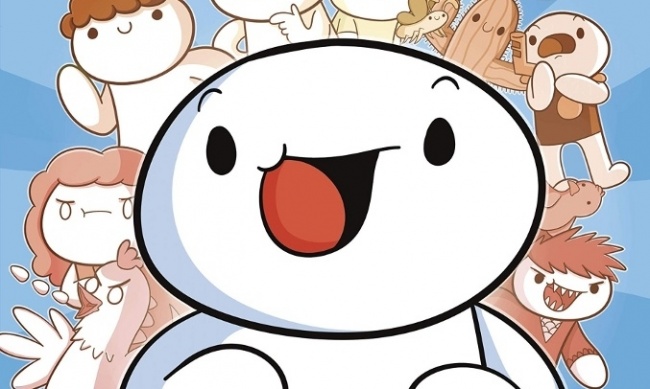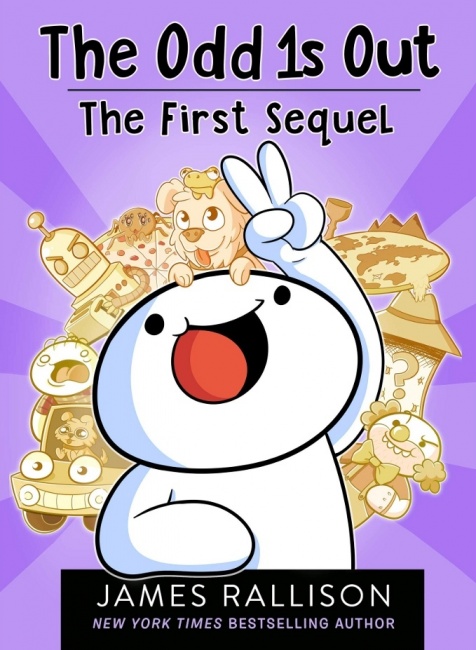A few weeks ago, I was on a business call on matters unrelated to anything fun or fan-oriented when one of the other people on the line became aware that I did some work in this area. "Tell you what," she offered, half joking, "I’ll give your team the contract if you can get something for my 11 year-old son from his favorite cartoonist…" I was waiting to hear the name Dav Pilkey, or maybe Kazu Kibuishi, Gene Yang or Jerry Kraft, none of whom I have on speed dial, but at least I’m aware of. I was not expecting what came next, though.
"James Rallison," she said.
My blank look must have been obvious even in my tiny corner of the Zoom screen. "You know," she said. "The Odd1sOut?"
As the parent of none, I was immediately flummoxed. A quick search revealed a modest archive of webcomics from 2012-2017 that are... not especially awesome, and a couple of illustrated sort-of-comics books published by TarcherPerigree, the most recent of which, released in March, 2020, was still doing well on Amazon.
But it turns out the book isn’t the product. The book, like the mountain of other Odd1sOut merchandise for sale on Rallison’s webiste is basically a keepsake for fans of Rallison’s YouTube channel, which has over 16 million subscribers and whose top videos clock in at well over 100 million views.
Those are big numbers in YouTube land for anyone not peddling beauty products or conspiracy theories: enough to make the 24 year-old Rallison a mega-superstar: just not one you’re likely to have heard of if you don’t have tweens in the house.
Let me tell you a story. TheOdd1sOut sits at the top of a YouTube genre called "storytime," which features 5-8 minute chunks of droll slice-of-life commentary from a GenZ or GenZ-ajdacent perspective, on top of something between basic illustrations and very rudimentary animation. On these clips, Rallison riffs on anything that annoys or delights him (mostly annoys, though), including roommates, wrong numbers, childhood memories, life during the pandemic, and his stint working the counter at a Subway sandwich shop (a recurring theme). Each moment of the fast-paced routines is punctuated by a vignette featuring the pale, blob-like, circle-two-dots-and-a-squiggle characters done in Rallison’s signature primitive art style.
Though the themes of TheOdd1sOut tend to focus on the problems of young adulthood, the audience is half a generation younger, and younger still for other storytime series that focus on more kid-centric topics. Seriously, I feel old just describing this.
Is it comics? Well, Scott McCloud would say no, but it’s as close or closer than some of the digital hybrid forms we’ve seen presented as comics over the past few decades. And it is ridiculously popular.
Storytime videos are becoming a huge influence on GenZ and post-GenZ (born 2015 or after), and their reach is only becoming more accelerated by the pandemic and the closure of schools and daycare, which is driving a lot more kids to spend a lot more time online while their crazed parents seek any avenue of relief.
Because they are so ubiquitous and accessible, storytime videos are shaping the aesthetics and expectations of the youngest audience just as surely as Saturday morning cartoons and other on-ramp media did for earlier generations. It’s worth paying attention to as an early warning system for what these kids might gravitate toward as they get old enough to buy or borrow books from stores or libraries.
Winning kids by pissing off parents. Rallison’s approach in TheOdd1sOut is also notable in that he, in his late teens and early 20s, is speaking to a much younger audience about stuff that is not yet part of their life experience, something that is very much against the grain of how kids graphic novels are now being manufactured by the big publishers. His blob-like characters lack much to identify them as any particular age, so they seem universal, but a lot of his humor derives from a weary frustration with the absurdity of the adult world, in a way that gives kids permission to not take grownups especially seriously.
That’s a formula that MAD mined for decades, but one that seems to have fallen out of favor in our more earnest times. Rallison’s satire is gentle, frequently self-deprecating, and cloaked in a much lighter degree of craft than the Usual Gang of Idiots brought to their work, which only helps it get under the radar of parents and prospective censors. Watch a couple of these videos and you’ll see that they can be quite perceptive and pretty pointed about calling out stupid stuff.
Parents who pay attention have mixed reactions to this. "Odd1sOut is one of the few YouTubers that doesn't drive me nuts," writes one representative of the pro-Rallison faction in the Amazon reviews of his latest book. "I love that his videos are clean and kid-friendly and honestly I think he is funny and often find myself listening in while my kiddos are watching. My 9, 10, and 11-year-olds all really wanted this book so we got it and they all took turns reading it immediately. They enjoyed reading it and said a lot of the stories were new and not on his YouTube channel (which was something I was concerned about). In less than a week they all three read it and said it was super funny and they highly recommend it."
Not everyone is a fan of his style. Rallison has come under criticism for his representation of special needs kids and for his frankness about certain subjects. "I hope your kid doesn’t believe in Santa if they read this," wrote one one-star reviewer. "And have you talked about STD’s yet? Well get ready for all that if you purchase this book. As someone who values raising children who are kind, inclusive, and responsible, I regret that I didn’t research better before my kid got into this guy. So, I’m hoping to save someone else the trouble."
Of course, a slight whiff of parental disapproval is a key ingredient to superstardom among pre-tweens, so I doubt Rallison sweats his haters much.
Is the Storytime genre an onramp to fan culture? Rallison is the most accomplished and among the most talented practitioners of Storytime videos, which have become such a huge deal on YouTube that people are already worried about backlash and oversaturation.
The production values of the genre are modest by design, which means the barriers to entry are low. That, in turn, leads to a lot of bad work coming online, all appealing to consumers with undeveloped tastes. Some of the work is worse than bad: it promulgates the same kind of stupidity and insanity rife elsewhere on YouTube, except targeting kids. Sturgeon’s Law is definitely coming into effect with a vengeance.
Another troublesome trend is that some ethically challenged producers are ripping off other artists from Instagram and elsewhere for character designs, or outright tracing their art to pump out content in hopes of getting on the gravy train. I hope they get a handle on that; in the meantime, it’s left to the YouTube community to police itself by calling out miscreants.
Even with those caveats in place, the success of TheOdd1sOut and the other legit top performers in the space show that Storytime videos can be a springboard for books, games, licensed merchandise and other media – all outside the view of most of the adult world. If folks in the fan culture business think they are smarter than an 11 year-old, now might be a good time to prove it.
The opinions expressed in this column are solely those of the writer, and do not necessarily reflect the views of the editorial staff of ICv2.com.
Rob Salkowitz (@robsalk) is the author of Comic-Con and the Business of Pop Culture.

Column by Rob Salkowitz
Posted by Rob Salkowitz on December 7, 2020 @ 3:03 pm CT





